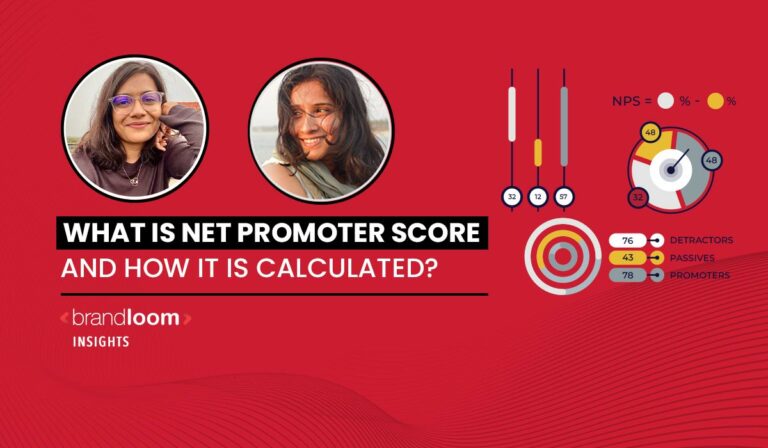Net Promoter Score (NPS) is a widely used metric that measures customer loyalty and their likelihood to recommend a company’s product or service to others.
It provides valuable insights into a company’s customer satisfaction levels, brand perception, and overall business performance.
However, despite its widespread popularity, NPS is not without its critics. Some argue that it oversimplifies customer feedback, while others question its reliability as the sole indicator of customer loyalty.
A lot of companies use NPS to keep insight into customer retention.
Customer retention is important for every company but even more important for SaaS companies. The churn rate is vital for SaaS companies since it measures how many customers will stick around and pay you.
In spite of the fact that there are many ways to reduce churn, Net Promoter Score (NPS) surveys have proven to be the most effective method.
Using NPS surveys and responding to them directly might reduce the churn rate by 30%.
You will retain more customers, generate new leads, and close more sales by capturing and acting on NPS. The situation is truly a win-win.
This article will delve deeper into the concept of NPS, its advantages and limitations, and how it can improve customer experience and drive business growth.
What is Net Promoter Score?
Net Promoter Score (NPS) is a measure of customer loyalty that identifies how customers recommend your brand, product, or service to others.
It measures the willingness of your customers to recommend you versus how likely they are to warn others against dealing with you.
The score is based on a simple principle: How likely is your customer to tell people about your business based on their experience with your company?
A high NPS score indicates positive word-of-mouth and an opportunity to increase loyalty, retention, and advocacy among happy customers.
A low score indicates a potential engagement crisis and an urgent need for action. Now moving further, let’s see what a good net promoter score is!
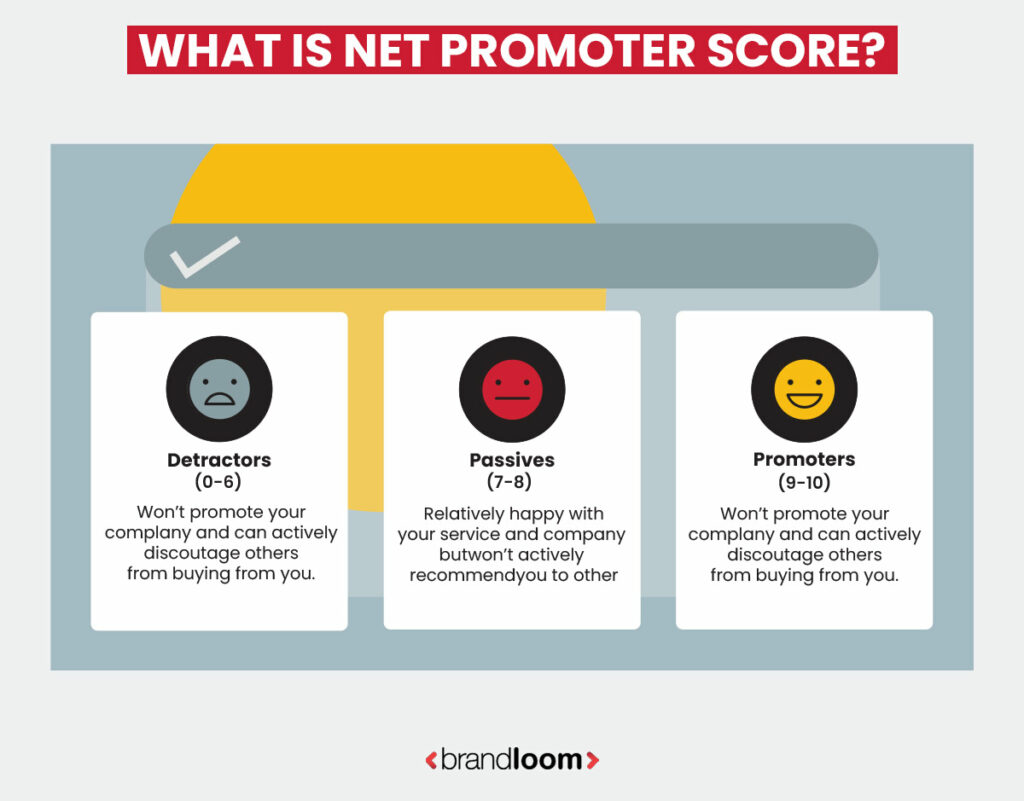
What is a Good Net Promoter Score?
Simply put, a high NPS score is a great sign for your company.
Anything above nine is considered excellent, while a score between 6 and 8 is very good.
A score below 6 indicates that your brand has a significant engagement problem and needs to act quickly.
A few things to keep in check: – Companies that are new to business don’t have an NPS score. They’re in the “zero” bucket. – You shouldn’t compare your company to others in your industry.
Focus on improving your score. – Your score may change over time as your customer base changes.
Your NPS score is unique to your company and your industry.
Why is NPS so important?
A high NPS score is a great sign for your business.
It means that your customers are happy with their experience and that they will recommend you to others.
A high score means that you’ve done a good job of satisfying your customers and that they have a positive brand association with your company.
A low score is a sign that your customers are unhappy. It would help if you acted fast to correct the problem so it doesn’t become a crisis.
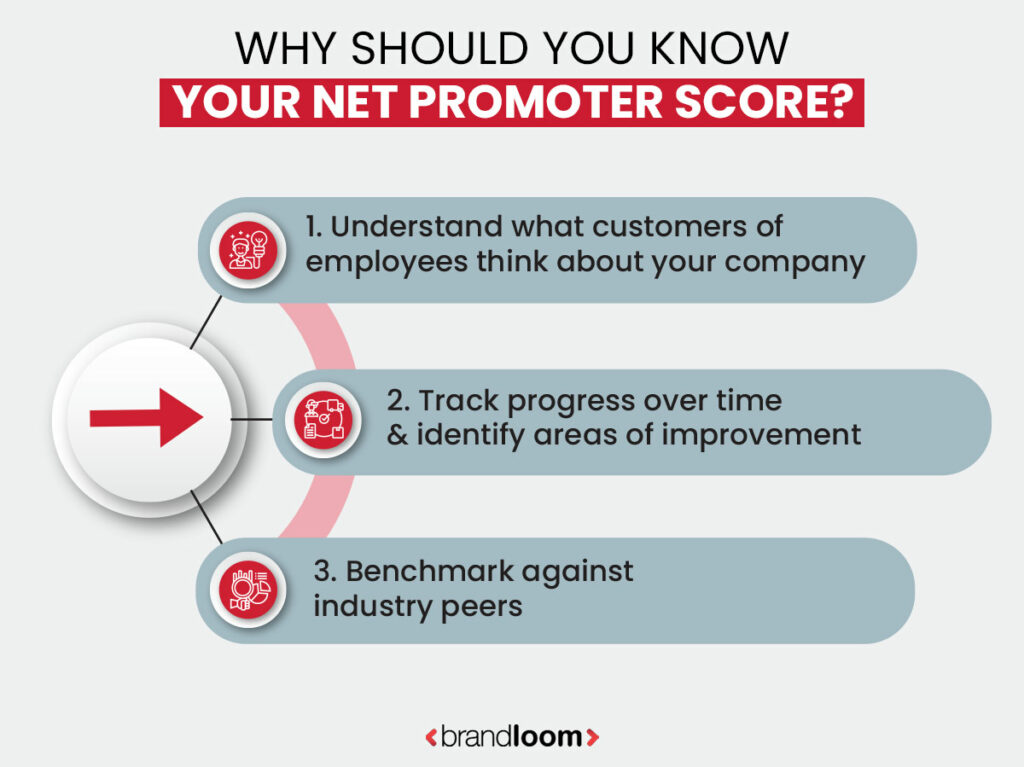
Measuring Customer Satisfaction and Loyalty by improving NPS
Customers’ willingness to recommend a company’s products or services to others is the Net Promoter Score (NPS) measure.
To calculate the score, customers are asked to rate their level of satisfaction on a scale of 0-10 and then part into Promoters, Passives, or Detractors.
- Promoters are customers who rate their satisfaction as a 9 or 10 and are considered loyal enthusiasts who will keep doing business with a company and refer others.
- Passives are customers who rate their satisfaction as a 7 or 8 and are generally satisfied but unenthusiastic.
- Detractors are customers who rate their satisfaction as a six or below and may be unhappy with the product or service, spread negative word-of-mouth, or churn (cancel their subscription).
The NPS is calculated by subtracting the percentage of Detractors from the percentage of Promoters.
So, if 50% of respondents are Promoters and 10% are Detractors, the company would have an NPS of 40.
The score can fall from -100 to 100, with anything above 0 considered good, 50 considered excellent, and 70 considered world-class.
How to calculate Net Promoter Score?
NPS Net Promoter Score calculation is based on the responses to a single question your customers are asked as part of a customer satisfaction survey.
The question is simple: How likely will you recommend the product or service to a friend or colleague?
Customers make a response on a scale from 0 – 10, with ten being “extremely likely.”
- Based on their responses, each customer is categorized as a Promoter (score 9-10): Customers who are “extremely likely” to recommend your product or brand. They like you so much that they might go out of their way to tell others about you.
- Passives (score 7-8): Customers who are “somewhat likely” to recommend your product or brand. And they are neither strongly positive nor strongly negative in their feelings about you.
- Detractors (score 0-6): Customers who are “not at all likely” to recommend your product or brand. They are so unhappy with their experience that they might discourage others from doing business with you.
NPS calculation
To calculate NPS, subtract per cent of customers who are “Detractors” from the percentage of customers who are “Promoters.”
Detractors are customers unhappy with your product or service, while Promoters are satisfied with your product or service.
To get your NPS score, subtract the percentage of Detractors from the percentage of Promoters.
For example, if you have a Promoter score of 80% and a Detractor score of 20%, your NPS would be 60.
It’s important to note that NPS is a comparative metric. In other words, you can use NPS to compare your customers’ satisfaction with your product or service relative to your competitors.
Net Promoter Score Action Plan
If you want to improve your Net Promoter Score (NPS), here’s a quick action plan to get you started. First, calculate your current NPS using the standard formula: NPS = % Promoters – % Detractors.
NPS = % Promoters – % Detractors
Once you have your score, look at your customer feedback to see what’s driving the score. Are there common themes among your promoters and detractors? If so, that’s a good place to start making changes.
Next, create some goals for improving your NPS. These could be specific actions like increasing the number of 5-star reviews you get or general goals like increasing customer satisfaction. Whatever you choose, make sure you have a plan for how you will achieve it.
Finally, track your progress over time and adjust your plan as needed. The most important thing is to keep moving forward toward your goal. With a little effort, you can see a big improvement in your NPS in no time!
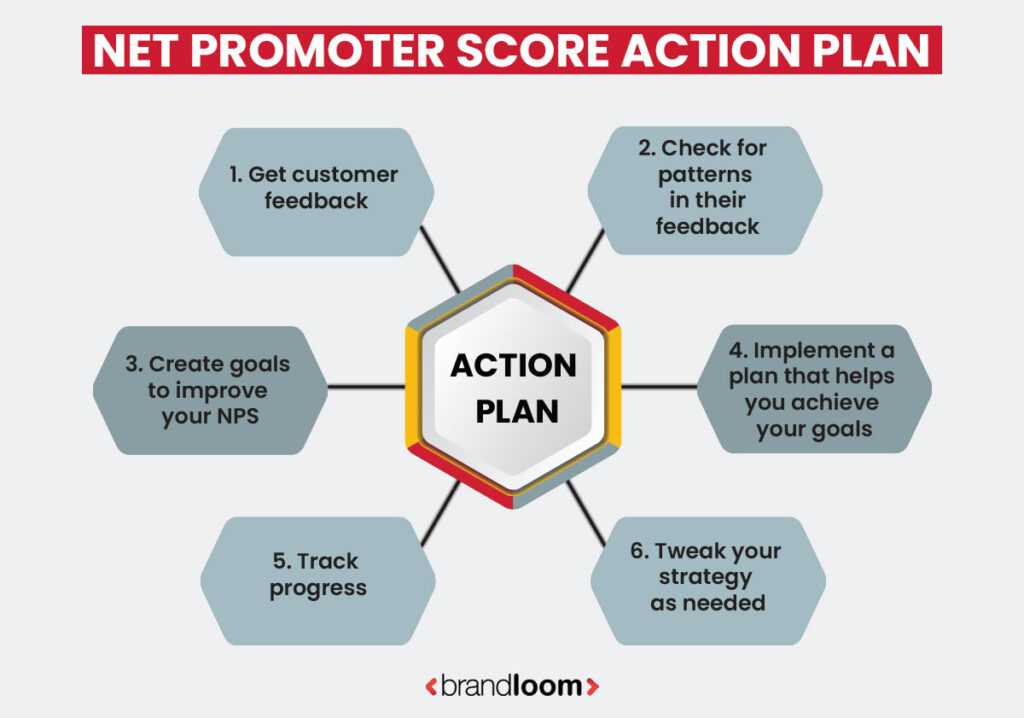
Net Promoter Score As an Employee Engagement Measure
Net Promoter Score (NPS) is a simple yet powerful measure of employee engagement. It’s calculated by asking employees how likely they are to recommend your company to others on a scale of 0 to 10. The NPS can track progress and compare results across different groups or departments.
There are many benefits to using NPS, including its ability to:
– Help you understand what customers or employees think about your company
– Enable you to track progress over time & identify areas of improvement
– Allow you to benchmark against other companies in your industry
If you’re not already using NPS, we highly recommend giving it a try. It’s a quick & subtle way to get valuable feedback from the people who matter most.
Designing NPS Survey – Use Additional Questions
For benchmarking your customer experience, measuring NPS alone is best.
But how do you improve it?
And what’s driving your NPS score?
This is where key drivers come in.
It is possible to determine the most important aspects of the experience that influence the score by understanding your customers’ experiences in greater depth.
If you are an online retailer, after a customer has completed a purchase with you, you might send them a customer survey asking, in addition to whether they are likely to recommend your business, the following:
- How easy was it to find the product you were looking for?
- What made you buy from us today [with multiple choices]?
- How easy were following parts of your journey? [Multiple choices]
In addition, you can also use operational data from your website analytics to layer in elements like:
- Time on page
- Referral URL
- Number of pages viewed
- Page load speed
This is just a quick snapshot of the data you could use to calculate your NPS score.
The more you include, the better your chances of identifying what is driving your score.
Once you have calculated your NPS, you will need significant data to run advanced analyses like Key Driver Analysis and Multivariate Regression to determine how to improve the customer experience and your NPS scores.
NPS Net Promoter Score Meaning with Example
The Net Promoter Score (NPS) is a widely used metric that measures customer loyalty and satisfaction. It provides insights into how likely customers are to recommend a company’s product or service to others. The NPS is calculated based on responses to a single question: “On a scale of 0 to 10, how likely are you to recommend [company X] to a friend or colleague?”
For example, let’s say a company conducts a customer survey and receives the following responses:
20 customers give a score of 0 to 6 (detractors)
30 customers give a score of 7 to 8 (passives)
50 customers give a score of 9 to 10 (promoters)
To calculate the NPS, we first determine the percentage of promoters and detractors:
Promoters: 50 customers / 100 total responses = 50%
Detractors: 20 customers / 100 total responses = 20%
Finally, we subtract the percentage of detractors from the percentage of promoters to get the NPS:
NPS = 50% – 20% = 30
In this example, the NPS score is 30, indicating that 30% of customers are highly likely to recommend the company’s product or service to others. A high NPS score indicates a strong level of customer satisfaction and loyalty, while a low score suggests that the company needs to improve its customer experience.
Ways To Conduct Net Promoter Score Surveys
NPS via email
The most common approach to eliciting customer responses is to send NPS surveys via email, but they are not always the most understandable.
The NPS survey is usually sent by email after your customers have made a purchase or have interacted significantly with you.
The NPS survey can be sent independently of other programs by sending your email list a link to the NPS. This method works well with a large database of highly responsive customers.
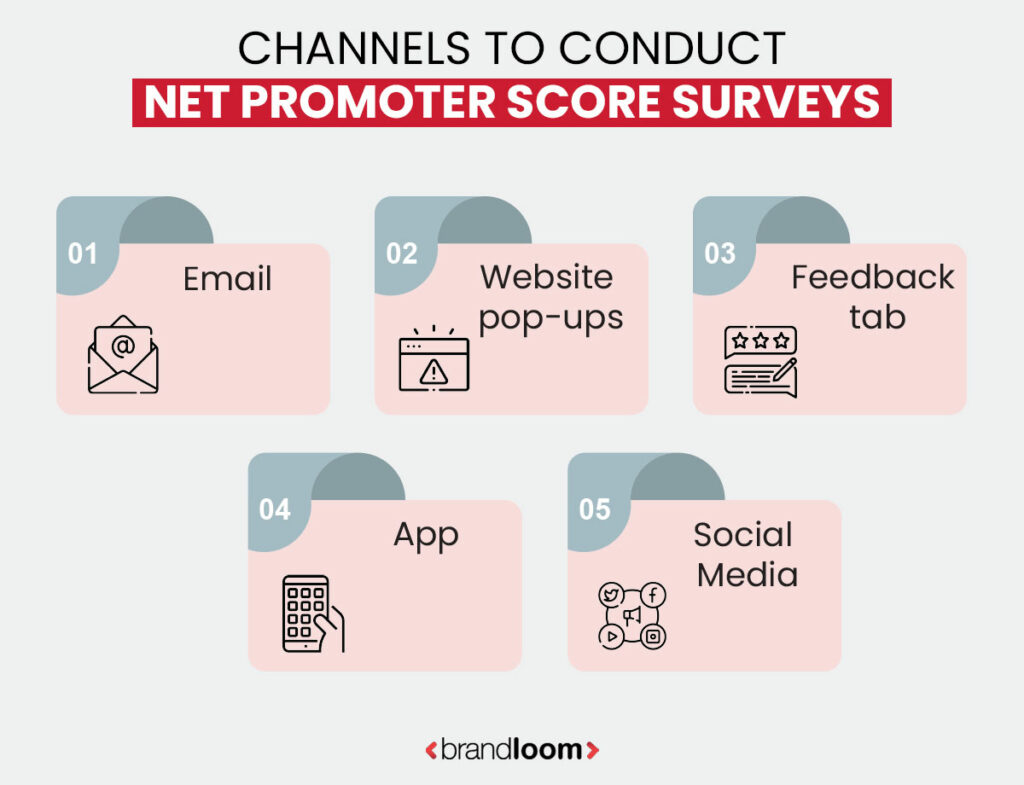
NPS via website pop-up surveys
You can ask for a survey where you want with pop-up surveys because you have more control over the deployment of your surveys.
You can, for example, trigger a survey to pop up right after the checking-out process if you want to gather insight into the customer experience right after the purchase stage.
A survey can also be triggered after a user has interacted with an agent if you want to understand their experience with support.
NPS via Feedback Tab
NPS surveys can be implemented through feedback tabs as a passive way to collect responses from your visitors.
If you are concerned about pop-ups disrupting your users, feedback tabs are a great alternative due to their lack of disruption.
NPS via Mobile: Apps and SMS Surveys
With NPS surveys sent via mobile apps and SMS, you can better engage your audience and collect feedback.
Since email and websites have been the primary way for companies to communicate with their customers for years, SMS has become the most direct way to reach your user, with over 90% open rates.
The shorter, simpler questions that can be answered from any location contribute significantly to that impressive number.
Sending the actual NPS survey is quite easy.
Design your NPS around the customer journey to maximize its effectiveness and grow your business.
Ways to utilize the NPS Survey information:
Pinpoint and overcome customer issues
You’ll often find people complaining about something you’ve already fixed or wanting a feature you offer or are planning on providing.
These surveys are the perfect way to find any problems or issues nagging your customers.
Accounts can be deactivated already, for example. You can turn this passive customer into a promoter with a simple question. Here are some tips that we use to respond to customer issues:
- Take a personalized approach with each customer. No auto-reply function works well, and you can gain value from talking to your customers.
- Reply to every comment regardless of whether it’s positive or negative.
- Pay close attention to detractors. They’re ready to leave your company at any moment.
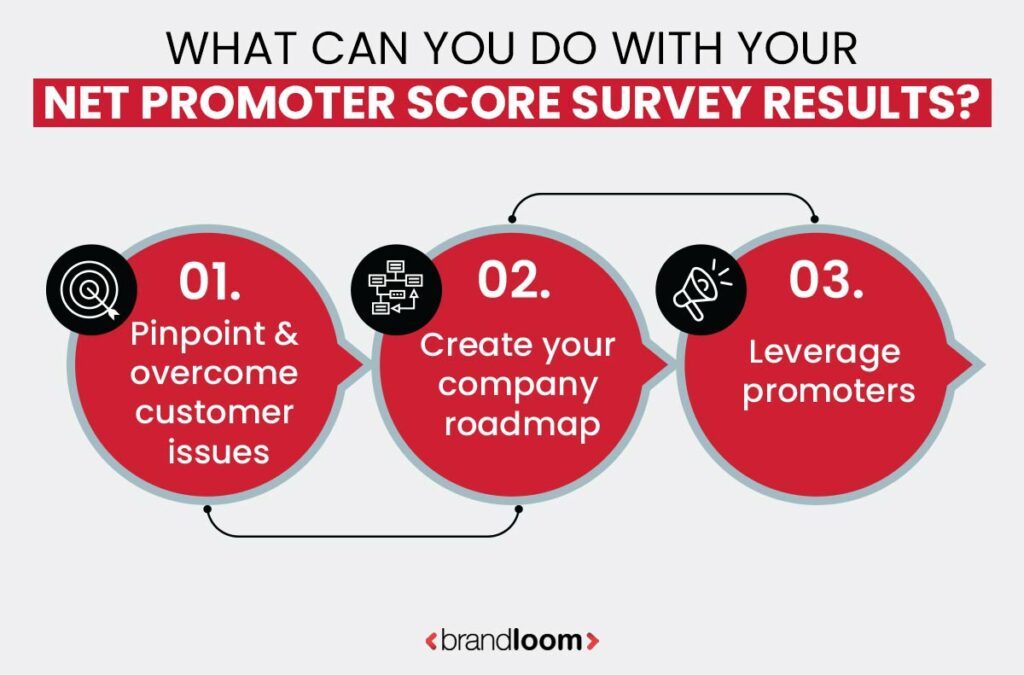
Pave your company roadmap.
NPS surveys have become essential to the company’s decision-making process.
It would be best if you noted every suggestion through the surveys. In a Google Sheets document, you can tally suggestions as they come in. It needs a little extra effort, but it’s well worth it.
You can make a product roadmap with loose deadlines if you know exactly what your customers want. We use this information to make a product roadmap with loose deadlines.
If your current customers are interested in a particular feature, your potential customers and leads will likely be.
Besides our Google Sheets document, we also tag each user’s suggestion that they’d like to see on our CRM platform.
The customer is then notified when their suggestion is added to the roadmap and also when it’s released.
People love knowing they’re being listened to, and the notifications delight them.
Leverage Promoters
Promoters love your product and don’t care who knows it. There are many ways that you can leverage them:
- Invite them to refer friends or colleagues
- Upsell them to a new package
- Ask for reviews on G2Crowd, Trust Radius, etc
- Share their encouragement with your company to boost morale
Deliver an exceptional customer experience with BrandLoom. Learn how to turn your customers into brand advocates at every touchpoint.
Conclusion: How Can NPS Improve Customer Satisfaction?
Customer Acquisition
If your NPS is low, leaderboards and other tools will tell you that you’re losing customers quickly.
If your NPS is high, you’ll indicate the positive word of mouth that will likely bring in new customers.
Customer acquisition is a complex process, and new businesses are not uncommonly to experience declining retention rates.
If your customers score you negatively on NPS, it could indicate that you’re losing customers at an alarming rate.
This will also show up in your acquisition numbers, and it may be impossible to overcome that deficit. Correcting the problem early is the best way to prevent a customer exodus.
Customer Engagement
Customers engaged with your brand are likelier to become loyal customers and advocates for your business.
NPS can quickly indicate how well your marketing strategies engage customers.
If you’re seeing a low NPS, that may indicate that customers aren’t satisfied with their experience and are taking action to express their dissatisfaction.
If your NPS is high, you’ll indicate the positive word of mouth that will likely bring in new customers.
Customer engagement is an ongoing process, and it’s important to keep a close watch on your NPS score to identify trends early and make adjustments as needed.
Customer Retention
If your customers are satisfied with their experience, they will remain loyal to your brand.
If they are not satisfied, they might consider other options. And if your NPS is low, you’re likely to lose customers quickly.
You will likely have a loyal customer base if your NPS is high. NPS can help you identify customers likely to leave soon so you can take action to retain them.
It can also help you identify customers who are likely to remain loyal so that you can give them extra attention.
Customer retention is an ongoing process, and it’s important to keep a close watch on your NPS score to identify trends early and make adjustments as needed.
Final Words
The Net Promoter Score is a quick and easy way to gauge how satisfied your customers are and how likely they are to recommend your brand to others.
A high NPS score indicates a strong likelihood of customer loyalty and an opportunity to increase customer retention and engagement.
The low NPS score indicates an urgent need for action to correct customer dissatisfaction before it becomes an engagement crisis.
Frequently Asked Questions on Net Promoter Score (NPS)
In Net Promoter Score (NPS) calculations, the percentage of customers who are detractors is subtracted from the percentage of customers who are promoters, yielding a score between -100 and 100.
Surveying your customers every couple of months is reasonable if every order is completely unique. If your product doesn’t change, you won’t need to survey your customers more than once every quarter to six months to make sure you’re maintaining the quality of service you’re providing.
A total of two types of NPS accounts are available at the moment: Tier 1 Accounts: Designed for employees in public & private sectors as well as other citizens of India. Tier 2 Accounts: Designed for general investments.
As a measure of customer loyalty, Net Promoter Score (NPS) subtracts the percentage of respondents who are “Detractors” from the percentage of respondents who are “Promoters.” To calculate Net Promoter Score (NPS), you subtract the percentage of respondents who are “Detractors” from the percentage of respondents who are “Promoters.”
NPS is important because it allows companies to track customer satisfaction over time and identify areas where they need to improve. Additionally, NPS can predict future business growth and help companies allocate resources more effectively.
Customers’ Net Promoter Scores (NPS) measure how likely they are to recommend the products or services of a company to others. A company’s Net Promoter Score (NPS) is calculated by asking its customers to rate their satisfaction from 0-10, then subtracting its detractors from its promoters.
NPS can be a useful metric for companies to track over time as it provides insights into customer satisfaction levels and can be used to rectify areas where improvements need. Additionally, NPS is a benchmark for a company against its competitors.
If you’re looking to calculate your company’s NPS, you can use a few different methods. One popular method is the Net Promoter System, which Fred Reichheld developed.
To calculate NPS using the Net Promoter System, you first need to survey your customers & ask them how likely they are to recommend the products or services on a scale of 0-10. Once you have the results of the survey, you will then need to calculate the percentage of promoters, detractors, and passives.
Promoters are customers who rated your company 9 or 10 out of 10.
On the basis of the number that respondent rates on, products or services are placed in the following 3 categories:
Promoters: these are the respondents who have responded with a 9-10 score.
Passives: these are the respondents who have responded with a 7-8 score.
Detractors: these are the people who have responded with a 0-6 score.
The NPS Calculation Formula
You can calculate your Net Promoter Score by subtracting the percentage of Detractors from the percentage of Promoters. NPS = % Promoters – % Detractors It is that simple. 50% of respondents were Promoters, and 10% were Detractors.
According to the creators of the NPS metric, Bain & Company, scores above 0 indicate good service, scores above 20 indicate great service, and scores above 50 indicate exceptional service. In general, scores above 80 indicate a high-performance level. However, a good score depends on whether you use an absolute or relative measurement.
When you send out an online poll with an NPS question, and a 0-10 scale, and you get 100 responses from customers, what do you do with the results? Averaging the responses isn’t the answer. The process is almost as simple as that.
According to the NPS system, you get a percentage based on what type of respondent you have—detractors or promoters. The steps for calculating the percentage are as follows:
– All survey responses are entered into an Excel spreadsheet.
– Take a look at each response, dividing them into Detractor, Passive, and Promoter responses.
– Add up all the responses from each group
– To get the absolute percentage, take the group total & divide it by the total number of survey responses.
– Now, subtract this percentage total of Detractors from the percentage total of Promoters—this will be your NPS score.
-Net Promoter Score (NPS) formula: (Number of Promoters — Number of Detractors) / (Number of Respondents) x 100
Net Promoter Score (NPS) is a customer satisfaction metric that measures the likelihood of customers recommending a company’s product or service to others. It is calculated based on responses to a single question: “On a scale of 0 to 10, how likely are you to recommend [company X] to a friend or colleague?”
Responses are then grouped into three categories: detractors (0-6), passives (7-8), and promoters (9-10). The NPS is calculated as the percentage of promoters minus the percentage of detractors. NPS is widely used to measure customer loyalty and overall customer sentiment towards a brand.
The Net Promoter Score (NPS) formula is calculated by subtracting the percentage of detractors (customers who gave a score of 0 to 6) from the percentage of promoters (customers who gave a score of 9 to 10). The formula is as follows:
NPS = (% of Promoters) – (% of Detractors)
For example, if a company surveyed 100 customers and received the following responses:
– 10 customers gave a score of 0 to 6 (detractors)
– 40 customers gave a score of 7 to 8 (passives)
– 50 customers gave a score of 9 to 10 (promoters)
The calculation of NPS would be as follows:
NPS = (50/100) * 100 – (10/100) * 100 = 50 – 10 = 40
In this example, the NPS score would be 40, which indicates that 40% of customers are likely to recommend the company’s product or service to others.
A high NPS score is generally considered an indicator of customer satisfaction and loyalty, while a low score may indicate that the company needs to improve its customer experience.

